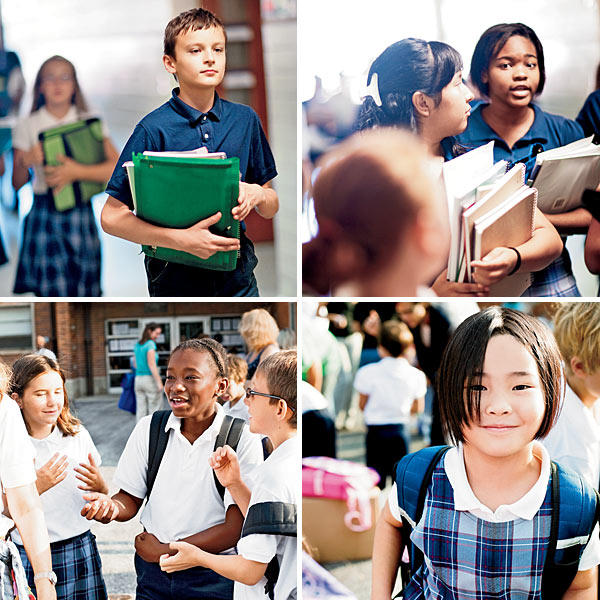
Children at Evanston’s Pope John XXIII School anticipate the beginning of another year of learning.
Related:
CHART: How Your Private School Stacks Up (pdf) »
Best Elementary Schools »
Our October 2010 story on the top schools in Chicago and the Suburbs
Methods and Sources »
Where we got the data and how we prepared our charts
“Kids like making choices,” says Rosalie Musiala, the principal of Evanston’s Pope John XXIII School, expressing a belief that undergirds the institution’s curriculum. After studying both French and Spanish from preschool through fifth grade, for instance, students make a decision in sixth grade to concentrate on one of those languages—or on Latin, “a language that really helps kids,” says Musiala. “It promotes the brain to look at things analytically.”
The decision making doesn’t stop there. In seventh grade (and again in eighth), students choose one option each semester from 20 different electives—classes that, in addition to their regular course of study, allow them to focus on music theory, drama, textile arts, and other subjects. It’s part of the process of helping the children discover who they are—and who they might become. “I wish everybody had this opportunity, that sense of ‘I’m special, I’m unique, and I’m going to be the best I can be,’” says Musiala.
It’s fitting that the curriculum at one of the area’s best private elementary schools was built on a foundation of choice. (Pope John XXIII has been recognized by the federal government as a Blue Ribbon School, an honor earned by only a handful of local schools.) All across Chicago and the suburbs, parents looking for an alternative to public schools regularly choose the area’s private schools to educate their children—and they have lots of options. The most obvious are the many denominational schools, such as the Bernard Zell Anshe Emet Day School in Chicago’s Lake View neighborhood, which combines Hebrew and Jewish studies with innovative educational programs, culminating, in eighth grade, with a two-week trip to Israel. But there are also Montessori schools, Waldorf schools, schools oriented toward science and the arts, and schools geared toward the particular needs of their students.
Consider Chicago’s St. Therese Chinese Catholic School, where the students collectively speak ten different languages—not counting English. No problem. The school not only works to make all its students proficient in English but also teaches them Mandarin and conversational Spanish. At its Chicago and Northfield campuses, Hyde Park Day School educates students with moderate to severe learning disabilities with the goal of eventually transitioning them to their local schools. In the south suburbs, Glenwood School for Boys and Girls—with a history extending back to 1887, when it was cofounded by Robert Todd Lincoln—provides a structured, residential learning environment for economically and socially disadvantaged children. And in a tough neighborhood on the West Side, the all-male Chicago Jesuit Academy offers its students full scholarships, a rigorous education, and the opportunity to learn that, in the words of one administrator, “it’s cool to be intellectually curious.”
All this special attention comes at a price. Unlike public schools, most of these private institutions charge tuition, which, as the charts beginning on this page reveal, annually runs into the thousands of dollars. That can be hard on some families, but there is help available. Although Chicago Jesuit Academy is alone in offering a full scholarship to each of its students, most schools provide some sort of financial aid package to needy pupils. But the greater price, if you will, is the demand put on students—and their parents—to perform at the highest possible level. As Musiala puts it, these are schools whose “culture buys into the hard work that brings success in the future.”
Much of the burden of ensuring that students succeed falls on the shoulders of a school’s teachers, as most principals readily acknowledge. “I think one of the biggest reasons for our success is the faculty,” says Colleen Cannon, the principal of Lincoln Park’s St. Josaphat, another Blue Ribbon School. “They are very dedicated and, because many of them are recent grads, very cutting edge. Like our students, they want to learn. And they have a lot of enthusiasm. They want to be in Catholic education, which is huge, because they don’t make as much as their public-school counterparts.”
Like other principals, Cannon is very concerned with encouraging the professional development of those teachers, regularly bringing in expert consultants to make sure that her instructors’ cutting edge isn’t dulled by time and routine. She also fine-tunes her school’s curriculum so that it connects with students at all levels. “You can’t just plan for the average [student],” she says. “You have to plan for all of them, including the gifted and the underperforming.”
The ability and opportunity to zero in on the particular needs of each student is a hallmark of the area’s private grade schools. “There’s a perception that we only take in smart kids,” says Musiala. “That’s not true. We take in [almost] everyone who applies, and we have kids with attention deficit disorder and kids who need speech therapy.” Combining early intervention with regular assessments and differentiated instruction, Musiala and her colleagues at Pope John XXIII School eliminate what she calls the “achievement gap.” For instance, in addition to a common reading program at each grade level, the school provides smaller guided reading groups that assist students who are having trouble keeping up—and other groups for students who have progressed beyond their peers. “We recognize students’ strengths and interests,” Musiala says, “and allow them to flourish. In a community, you value the skills of everyone in the room, and you know the areas of weakness so you can help bolster them. We set the bar pretty high here, but working together, we—parents, teachers, and students—can make everyone successful.”
Photography: Anna Knott


